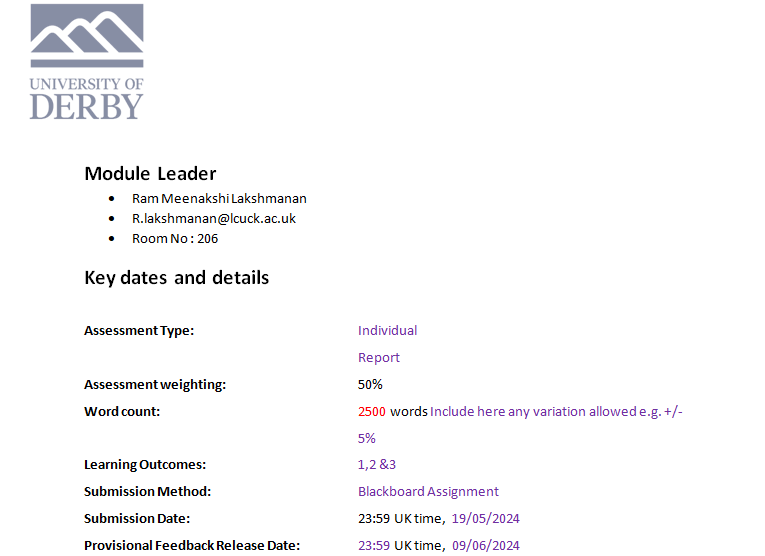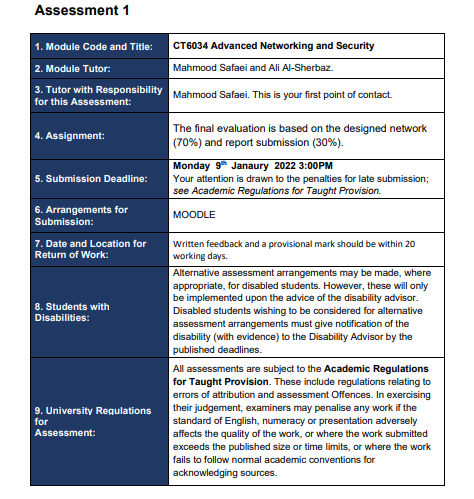An individual report with 2000 words about “Sensors and Control” consists of LO1, LO2 and LO3 which covers introduction, results and analyses and conclusions.
University of Derby – Sensors and Control 6EJ538
Original price was: $280.00.$140.00Current price is: $140.00.
Description
Description of the assessment
L01: Design, build and evaluate a complete sensing system by selecting the appropriate sensor(s), signal conditioning and data acquisition techniques to meet specific applications.
Learning Objectives are to:
- To Familiarise with construction principles of various sensors on the sensor kit board
- Learn and compare chosen sensors based on accuracy and resolution
- Study and comment on static and dynamic characteristics of chosen sensors.
Preparation Work:
You need to revise some of the sensors you come across in this module towards your objectives. Think of procedures to carry out in order to fulfil the objectives.
Task 1(satisfies Part of L01)
You have been asked by your supervisor to develop prototype of a data logger that measures the Water level and Distances up to 200cms and transmits the data via a standard USB cable to a PC where the time sampled data is recorded in a file.
Your results should be submitted in a report format detailing the following
- Introduction
- Theory of operation for each of the transducers employed
- Results including any programs (pseudo code and flow charts)
- Conclusions
Award of Marks
Marks will be awarded in the following categories:
Circuit Completion and Demonstration: 10%
Comprehension and Understanding: 10%
Report: 20%
L02: Analyse and critically evaluate theoretically and practically the performance of commonly used control systems.
Learning Objectives are to:
- understand transfer functions of dynamic systems
- understand response of a systems to step inputs
Preparation Work
You need to familiarise yourself with the basic concepts of open-loop and closed loop control systems.
Task 2.0 (satisfies Part of L02)
Digital DC Motor Speed Control with PID Control
Design a discrete control system by converting the continuous transfer function to a discrete transfer function.
Fig 1.0 shows the Block diagram of an armature controlled dc Motor.
Fig 1.0
DC Motor Parameters
Moment of Inertia of the motor J=0.01 kg.m^2/s^2;
Damping(friction) of the mechanical system b=0.1Nms;
Back emf constant K=0.01 NM/Amp;
Resistance R=1ohm;
Inductance L=0.4H;
Desired input
The unit step reference input for all simulations.
Design criteria
- Settling time less than 2 seconds
- Overshoot less than 5%
- Steady-state error less than 1%
Procedure
- Obtain the transfer function using Simuliink and verify the result obtained using Matlab.
- Design the continuous PID controller.
- Obtain the optimum analogue PID parameters from the analogue PID controller
- Convert the continuous-time PID compensator to discrete-time PID compensator by using the “tustin” method in this case.
Submit a written report detailing the following:
- Introduction
- Results and Analyses
- Conclusions
Award of Marks
Marks will be awarded in the following categories:
- Simulation and Demonstration: 10%
- Comprehension and Understanding: 10%
- Report: 20%
L03: Analyse and assess theoretical and practical issues relevant to the design and application of sensors and control systems.
Learning Objectives are to:
Understand the theoretical and practical issues involved in the design of control systems.
Preparation Work
You need to familiarise yourself with the characteristics of various sensors and with basic concepts of open-loop and closed loop control systems.
Task 3.0
You are required to analyse and assess theoretical and practical issues involved in the design of temperature and humidity monitoring and Control systems in a building.
You need to address the following key issues :
- What control accuracy is needed?
- How and where will the controlled variables (temperature and humidity) be sensed by the controls
- What level of reliability is required?
- Communication to the central control room
- Closed loop control system
- Types of Actuators employed
You are required to submit an assignment of 1500 to 2000 words only
The report must include :
- Introduction
- Results and Analysis
- Conclusions
Award of Marks
Report: 20%
Total marks = 100%






Reviews
There are no reviews yet.